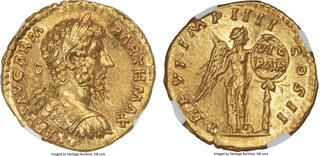Lot description:
Ancients
Lucius Verus, as Augustus (AD 161-169). AV aureus (19mm, 7.32 gm, 5h). NGC MS 5/5 - 4/5, Fine Style. Rome, summer-December 166. L VERVS AVG ARM-PARTH MAX, laureate, cuirassed bust of Lucius Verus right, seen from behind / TR P VI•IMP IIII COS II, Victory standing facing, head right, nude to waist, placing shield on palm tree to right, shield inscribed with VIC / PAR. Calicó 2190, same obverse die; reverse die of 2088. RIC III (Marcus Aurelius) 564. BMCRE (Aurelius) 430 note. Faces of Power 349 (this coin). This coin published in H. Gitler & G. Gambash, Faces of Power: Roman Gold Coins from the Victor A. Adda Collection (Jerusalem, 2017). Marvelous portrait with exquisite artistry and detail, flowlines beaming upward from crown of head like an aureole of light.
Ex Roma Numismatics, Auction XXV (22 September 2022), lot 1039; Numismatica Ars Classica, Auction 119, 6 October 2020, lot 127; Victor A. Adda Collection, Christie's Highly Important Ancient Coins, 9 October 1984, lot 85.
Born Lucius Ceionius Commodus, Lucius Verus was the son of Aelius Caesar, the favored heir of Emperor Hadrian. Aelius's premature demise in AD 138 thrust Lucius into the uncertainty of imperial succession. Hadrian instead chose to adopt Antoninus Pius as his replacement, a seasoned senator who agreed to ascend to the throne on the condition of a more hereditarily adoptive line of succession by naming both Lucius--the son of Hadrian's initial choice as heir--and Hadrian's great-nephew Marcus Aurelius as his heirs. Following the death of Antoninus Pius in 161, the Senate planned to confirm Marcus alone, but he insisted on Lucius's elevation to Augustus. Lucius would take on Marcus' family name, "Verus". Their co-reign forged an unprecedented partnership at the zenith of Roman power, amidst the distant thunder of Parthian aggression. Lucius, with the mantle of military leadership thrust upon him, embarked on a campaign to repel the eastern threat. His notorious affair with a low-born mistress caused Marcus to fast-track Lucius' marriage to his thirteen-year-old niece, Lucilla, in 163. Although Lucius spent the duration of the war living a life of luxury and licentiousness in Asia Minor, the success of his generals in reconquering the Armenian capital at Artaxata and sacking the Parthian capital at Csetiphon earned him a triumph in 166 and two new titles-Armeniacus and Parthicus Maximus. Yet these victories also sowed the seeds of catastrophe. As the Roman legions returned, they brought back with them an epidemic that would ravage the Empire-the Antonine Plague. Returning from the Germanic front in 169, Lucius succumbed to the merciless grip of smallpox, a victim of the very plague his victories had unwittingly unleashed.
https://coins.ha.com/itm/ancients/roman-imperial/ancients-lucius-verus-as-augustus-ad-161-169-av-aureus-19mm-732-gm-5h-ngc-ms-5-5-4-5-fine-style/a/3115-31085.s?type=DA-DMC-CoinArchives-WorldCoins-3115-05082024
HID02906262019
© 2024 Heritage Auctions | All Rights Reserved
Estimate: 8000-10000 USD |  |